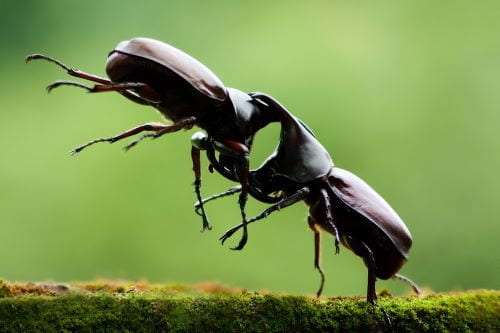Deforestation is a leading cause of species loss in the tropics. In an article published last week in the journal Ecology Letters, ASE Asst Prof Eleanor Slade and co-authors show that how well animals survive deforestation may depend on their mating strategy.
The researchers studied different species of dung beetles in the tropical rainforest of Sabah in Malaysian Borneo. The males of these different species of dung beetles have different approaches to mating; some are fiercely competitive and fight for mates with horns, while others don’t have horns or fight at all. What the study showed was that the horned, fighting beetles were less likely to go extinct following deforestation.
Development of traits specifically for the purpose of fighting or competing for mates, such as antlers, horns or ornamental feathers, through the process of sexual selection benefits a few individuals, who get to father many offspring. But it has not been clear whether such traits benefit survival at the species level, since they can often be both costly for the animal to produce and rather unpractical in daily life, for example exposing the individual to predators.
After tracking down 34 species of beetles in sites ranging from pristine “old-growth” forest, through various stages of logging and finally into oil palm plantations where the original forest has been almost completely replaced, the researchers found that species with horns were more likely to persist in the disturbed environments than were those without horns. And not only were the horned beetles more resilient, the larger the horns, the better their populations were doing. In the oil palm plantation, only 11 out of 34 species of beetle remained, and they all had horns.
Dr Rob Knell, co-author from Queen Mary University of London comments: “… When a population is stressed by changes to the environment the winning males can be the ones best adapted to the new environment, and this can boost the rate by which the population adapts to the new environment, making them less likely to go extinct. This is something that has long been predicted theoretically but it is the first time that this effect has been shown in the field.”
Dr Eleanor Slade from Nanyang Technological University in Singapore adds “This tells us that if we want to understand how animals can adapt to changing environments then we need to think about their mating systems as well as other aspects of their biology. Understanding which species may be particularly prone to extinction after environmental change is important when evaluating species conservation status and management practices.”
These traits are also, however, indicators of an individuals’ condition and can reflect underlying genetic quality. Strong sexual selection can therefore enhance the spread of beneficial genetic variants by the mechanism explained above potentially reducing extinction risk.
Find the origninal article in Ecology Letters here
The study featured in The Conversation


